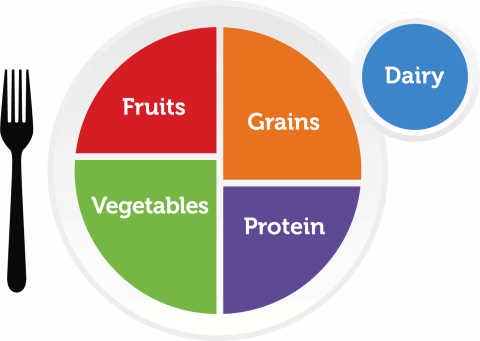For decades the U.S. Department of Agriculture (USDA) has developed tools and resources to help us improve child nutrition. MyPlate.gov is a nutritional food guide designed to help Americans become more aware of what they are eating and to assist them in making better food choices. The concept uses the place setting that includes a glass and plate to show how the food groups should be distributed over the daily meals to provide individuals with the recommended daily intakes of nutrition.
MyPlate is based on the Dietary Guidelines for Americans that is updated every five years. Although these dietary guidelines are written for health professionals, MyPlate provides a tool and visual representation for individuals, nutrition educators, and the food industry to help consumers build healthier diets. The 2020 MyPlate model, shown below, shows a plate containing the five food groups (fruits, vegetables, proteins, grains, and dairy) in a place setting.
MyPlate breaks food into five groups: fruits, vegetables, grains, protein and dairy products. Although all foods within a group are basically treated the same, consuming a balanced diet of these food groups as recommended in MyPlate helps you eat healthier. This concept is designed for healthy people and does not consider special diets for people with special needs that alter the nutrient requirements of the body. People with special conditions should discuss their needs with their healthcare providers and follow their advice.
Five Food Groups
Each MyPlate food group includes a variety of foods with similar nutritional makeup, and each group plays an important role in an overall healthy eating pattern. Here is an overview of the five food groups illustrated in the MyPlate model. The amount of each group needed for a nutritious diet will vary based on age, sex, height, weight, and level of physical activity.
- Fruits: The fruit category includes whole fruit and fruit juices. In general, 1 cup of fruit or 100% fruit juice, or ½ cup of dried fruit is considered as 1 cup from the Fruit Group.
- Vegetables: Like fruit, any vegetable or 100% vegetable juice counts as part of the vegetable group. They may be raw or cooked; fresh, frozen, canned, or dried/dehydrated. They may be whole, cut-up, or mashed. Based on their nutrient content, vegetables are organized into 5 subgroups: dark green; red and orange; beans, peas, and lentils; starchy; and other vegetables. In general, 1 cup of raw or cooked vegetables or vegetable juice, or 2 cups of raw leafy salad greens is considered as 1 cup from the vegetable group.
- Grains: Any food made from wheat, rice, oats, cornmeal, barley, or another cereal grain is a grain product. This includes bread, pasta, breakfast cereals, grits, tortillas, popcorn, rice, and oatmeal. Grains are divided into whole grains and refined grains. At least ½ of the grains you eat should be whole grains. In general, 1 slice of bread, 1 cup of ready-to-eat cereal, or ½ cup of cooked rice, cooked pasta, or cooked cereal is considered as 1 ounce-equivalent from the Grains Group.
- Protein: Foods made from seafood; meat, poultry, and eggs; beans, peas, and lentils; and nuts, seeds, and soy products are part of the protein food group. Beans, peas, and lentils are excellent sources of plant protein and are considered a part of the Protein Group. In general, 1 ounce of meat, poultry or fish, ¼ cup cooked beans, 1 egg, 1 tablespoon of peanut butter, or ½ ounce of nuts or seeds is considered as 1 ounce-equivalent from the Protein Foods Group.
- Dairy: The Dairy Group includes milk, yogurt, cheese, lactose-free milk and fortified soy milk and yogurt. It does not include foods made from milk that have little calcium and high-fat content, such as cream cheese, sour cream, cream, and butter. In general, 1 cup of milk, yogurt, or soy milk, or 1 ½ ounces of natural cheese is considered as 1 cup from the Dairy Group.
Tools and Apps to Track Nutrition
Since the number of servings from each food group is based on a person’s age, sex, height, weight, and level of physical activity, determining how much of each food to eat per day may seem overwhelming. However, the USDA has developed tools to help. MyPlate has two useful tools:
- MyPlate Plan. This is a personalized food plan based on your age, sex, height, weight, and physical activity level. It helps you figure out how many calories you need each day. Then it shows you food group targets—what and how much to eat within your personalized calorie allowance.
- MyPlate APP. This helps you build healthy eating habits. It is a mobile app that will help you choose daily food goals and see your progress in real time.
Using these tools, parents and nannies can get a greater understanding of nutrition and how to teach children healthy eating habits. If you are a nanny and want to learn about child nutrition, there are several courses available at the Nanny Institute.


Recent Comments